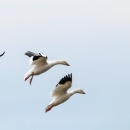About Us
Emiquon National Wildlife Refuge was established in 1993 to restore and protect wetland habitats at the confluence of the Illinois and Spoon Rivers and to help fulfill international obligations contained in various migratory bird treaties and conventions. The first tract of the refuge was purchased on December 29, 1993. The refuge has since grown to 2,631 acres. In 2012, the refuge was designated as a Ramsar Wetland of International Importance. The refuge is part of the traditional homeland of the Illinois people, past and present. Today, the Illinois people are recognized as the Peoria Tribe of Indians of Oklahoma, a confederation of Kaskaskia, Peoria, Piankeshaw and Wea tribes of Illinois and Indiana. They are descendants of those who created the great mound civilizations in the central Unites States. Subsequent tribes that also lived here were the Kickapoo and Potawatomi. We honor with gratitude their past and present as we continue stewardship of these lands, waters, fish and wildlife.
Emiquon refuge is managed as part of the Illinois River National Wildlife and Fish Refuge Complex, this complex stretches along 124 miles of the Illinois River in west central Illinois and consists of three refuges: Emiquon National Wildlife Refuge, Chautauqua National Wildlife Refuge and Meredosia National Wildlife Refuge. The complex totals 13,000 acres of backwater lakes, bottomland forests, floodplain wetlands and upland habitats.
In addition to U.S. Fish and Wildlife Service managed lands, The Nature Conservancy owns more than 7,000 acres adjacent to Emiquon National Wildlife Refuge. This area, called Emiquon Preserve, is managed by The Nature Conservancy to restore functional floodplain habitats along the Illinois River. The property includes Thompson Lake, which was once one of the most ecologically significant backwater lakes in the Illinois River floodplain.
While wildlife is the showcase feature at Emiquon National Wildlife Refuge, the wider Emiquon area has a much bigger story to tell. This story encompasses thousands of years of human and natural history. The rich plant and animal life that once thrived in this area provided resources that sustained human cultures for more than 12,000 years. A trip to the Illinois State Museum Dickson Mounds will provide abundant opportunities to explore this rich story. The museum is located just north and west of the refuge.
Our Mission
The mission of the National Wildlife Refuge System is to administer a national network of lands and waters for the conservation, management and, where appropriate, restoration of the fish, wildlife and plant resources and their habitats within the United States for the benefit of present and future generations of Americans.
Every national wildlife refuge national wildlife refuge
A national wildlife refuge is typically a contiguous area of land and water managed by the U.S. Fish and Wildlife Service for the conservation and, where appropriate, restoration of fish, wildlife and plant resources and their habitats for the benefit of present and future generations of Americans.
Learn more about national wildlife refuge was created for a special purpose. Some were created to protect migratory birds, others to protect threatened or endangered species or unique habitats, while others fulfill another special purpose. All activities allowed on refuges must be evaluated to make sure each activity will not conflict with the reason the refuge was founded.
Emiquon National Wildlife Refuge was established under the Emergency Wetlands Resources Act of 1986. The purpose the refuge is for the conservation of the wetlands of the nation in order to maintain the public benefits they provide and to help fulfill international obligations contained in various migratory bird treaties and conventions.
Our History
12,000- years ago- Human history begins in the Emiquon area. The abundant natural resources continue to support over 600 generations civilization.
December 29, 1993 - The first parcel of land was purchased, putting Emiquon refuge on the map.
Summer 2006- The first bald eagle fledgling was spotted in the Emiquon area.
February 2, 2012 - The refuge recognized as a Wetland of International Importance by the Ramsar Convention.
Winter 2019- The highest one-day count of bald eagles is the Emiquon area is recorded: 332 eagles.
Other Facilities in this Complex
Emiquon National Wildlife Refuge is managed as part of the Illinois River National Wildlife and Fish Refuge Complex. This complex stretches along 124 miles of the Illinois River in west central Illinois and consists of three refuges: Emiquon National Wildlife Refuge, Chautauqua National Wildlife Refuge and Meredosia National Wildlife Refuge. The complex totals 13,000 acres of backwater lakes, bottomland forests, floodplain wetlands and upland habitats and provides habitat for 60% to 70% of the waterfowl that migrate along the Illinois River. Refuges in the complex have been designated as an Important Bird Area, a Ramsar Wetland of International Importance and has been accepted into the Western Hemisphere Shorebird Reserve Network.


